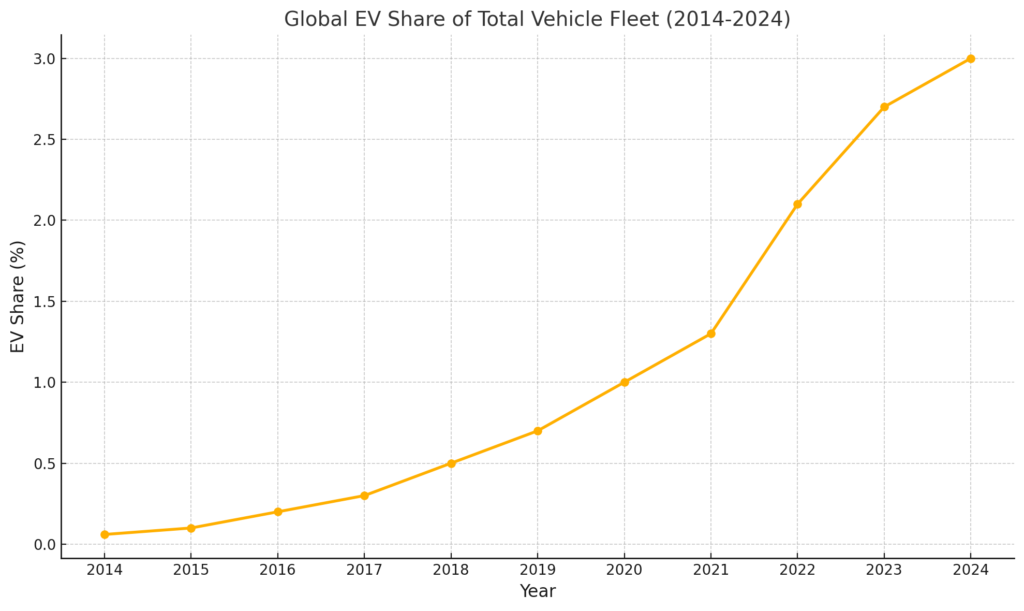In just a decade, electric vehicles (EVs) have transformed from a niche market to a driving force in the global automotive industry. The rapid adoption of EVs reflects advancements in technology, decreasing battery costs, and growing environmental consciousness. Let’s explore how EV adoption has evolved globally from 2014 to 2024 in terms of total numbers and percentages, using data and a detailed graph to visualize this transformative journey.
Global EV Growth in Numbers
The growth of EVs worldwide has been nothing short of remarkable. In 2014, there were fewer than 500,000 EVs globally. By 2024, this number has skyrocketed to approximately 50 million EVs—a staggering 100-fold increase in just ten years. This growth is driven by:
- Technological Advancements: Falling battery costs, improved range, and faster charging.
- Policy Support: Government subsidies, incentives, and mandates for clean energy.
- Consumer Awareness: Growing recognition of the environmental and economic benefits of EVs.
EVs as a Percentage of Total Vehicles
While EV numbers have grown significantly, their share of the global vehicle fleet tells an equally compelling story. The table below highlights the percentage of EVs in the total vehicle fleet from 2014 to 2024:
| Year | EV Share (%) |
|---|---|
| 2014 | 0.06% |
| 2015 | 0.1% |
| 2016 | 0.2% |
| 2017 | 0.3% |
| 2018 | 0.5% |
| 2019 | 0.7% |
| 2020 | 1.0% |
| 2021 | 1.3% |
| 2022 | 2.1% |
| 2023 | 2.7% |
| 2024 | 3.0% |
The global EV share has grown from a mere 0.06% in 2014 to an estimated 3.0% in 2024. While this may seem modest, it reflects a steep adoption curve in the context of a global vehicle fleet that exceeds 1.475 billion vehicles.
Visualizing the Growth
The graph below provides a visual representation of the exponential growth in EV adoption over the past decade:

Key Milestones and Trends
- 2014–2019: The Early Years
- EV adoption was slow but steady, driven by early innovators like Tesla with the Model S and Model 3, and policy support in regions like Norway and California.
- By 2019, EVs made up 0.7% of the global fleet.
- 2020–2022: Entering the Mainstream
- Falling battery prices and expanded model availability (especially in China and Europe) propelled EV growth. By 2022, EVs accounted for 2.1% of the global fleet.
- 2023–2024: Accelerated Adoption
- EVs reached 2.7% of the global fleet in 2023 and are estimated to hit 3.0% in 2024.
- Key drivers include China’s dominance in EV production, government mandates, and the affordability of models like the Tesla Model Y and BYD offerings.
The Road Ahead
While EVs still make up a small fraction of the total global vehicle fleet, the pace of adoption is accelerating. Analysts project that EVs could comprise 10% of the global fleet by 2030, supported by:
- Aggressive policy goals (e.g., bans on internal combustion engines in Europe by 2035 and 2030 in other markets).
- Continued innovation in battery technology (e.g., solid-state batteries).
- Expanding infrastructure (e.g., faster and more widespread charging networks).
Conclusion
The past decade has shown us that the electric revolution is not just a possibility but an undeniable reality. The rapid growth from 500,000 BEVs in 2014 to a staggering 50 million in 2024 illustrates a transformation driven by the powerful trifecta of policy, innovation, and free market forces. Despite resistance from legacy automakers and industries invested in the status quo, the tide of change is relentless and irreversible.
What makes this shift even more remarkable is that it underscores a crucial point: we don’t need to resort to extreme actions or dismantle capitalism to tackle the climate crisis. Activist groups like Just Stop Oil may aim to draw attention to the urgency of change, but the trajectory of the electric revolution shows that capitalism—when aligned with innovation and sustainability—is capable of dismantling the dominance of fossil fuels by itself. Market forces, driven by consumer demand and technological advancements, are accelerating this transition faster than even the boldest predictions.
This is a reassuring realization. It means that solutions can arise from within the system, leveraging competition, creativity, and the pursuit of progress. The world is witnessing the emergence of a new economic and industrial paradigm—one that not only reduces our dependence on fossil fuels but also redefines how we innovate, consume, and thrive. The revolution is here, and it’s proving that change, when fueled by purpose and profit, can be both transformative and sustainable.

